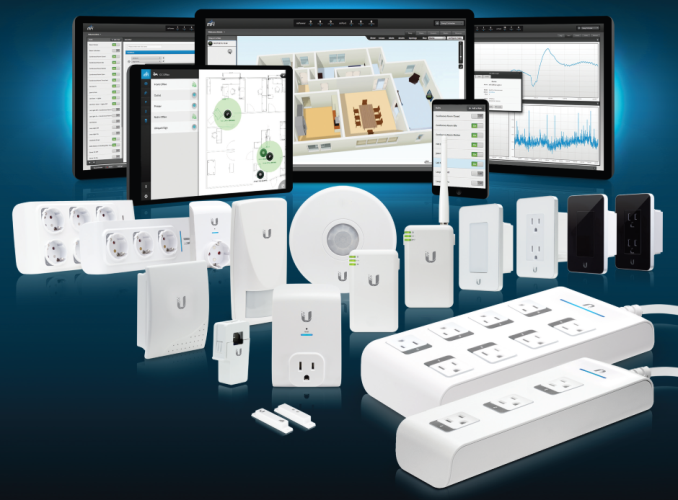Belkin WeMo and Ubiquiti mFi Home Automation Platforms Review
by Ganesh T S on April 27, 2015 8:00 AM EST- Posted in
- Home Automation
- Belkin
- Ubiquiti Networks
- IoT
Miscellaneous Aspects and Concluding Remarks
Home automation needs to be 'green'. Tracking the power consumption of battery-operated devices is challenging. However, we are only looking at AC-powered devices today. In order to do some evaluation. we connected the WeMo Insight Switch and mPower (3-port) to the two outlets of a mFi In-Wall Outlet. The instantaneous power consumption was tracked every second over a 5-minute interval for different situations and the results are tabulated below.
| Power Consumption Metrics Belkin WeMo Insight & Ubiquiti Networks mPower |
||
| Device | Notes | Average Power Consumption (W) |
| WeMo Insight | Relay Off | 1.44 |
| Relay On - No Load | 1.86 | |
| Relay On - 38W Load | 39.14 | |
| mPower | Relays Off | 0 |
| Relay On x1 - No Loads | 1.54 | |
| Relay On x2 - No Loads | 2.05 | |
| Relay On x3 - No Loads | 2.55 | |
| Relay On x3 - 38W Load x1 | 40.05 | |
The mPower consumes insignificant power to remain connected to the Wi-Fi network, while the Belkin Insight consumes an average of 1.44 W for this purpose. Turning on the relays ends up consuming power as shown above. Based on the above observations, Belkin can optimize the firmware and/or platform choice to give consumers a more power efficient product. The mPower consumes power within reasonable limits with the relays turned on. However, the AR9331 is by no means a low-power Wi-Fi SoC. It will be interesting to see the Wi-Fi SoCs used by Ubiquiti Networks in future iterations in this product space.
Interoperability is another aspect of home automation systems. While the WeMo is officially a closed platform, the reverse engineered aspects have made it possible for even the mFi controllers to control WeMo devices.
Earlier this month, we arrived at a set of points to ponder when dealing with any home automation system / device. Using those, we have come up with a summary table that provides essential information about the Belkin WeMo and the Ubiqiuiti Networks mFi at a glance.
| Home Automation Device Aspects - Summary Table | ||
| Aspect | ||
| Evaluated Devices | Light Switch Insight Switch |
mPower mPower Pro InWall Outlet InWall Dimmer Switch |
| Communication Technology | Wi-Fi (2.4 GHz) | Wi-Fi (2.4 GHz) |
| Platform | Ralink / MediaTek RT5350 1x1 802.11n Wi-Fi SoC Host CPU: MIPS 24KEc, DRAM: 32MB |
Qualcomm Atheros AR9331 1x1 802.11n Wi-Fi SoC Host CPU: MIPS 24Kc, DRAM: 32MB |
| Power Source | AC Powered | AC Powered |
| Hub / Bridge Requirement | No | No |
| Control Center | Local Device (basic access) Cloud (rules and scenes) |
Local Device (basic access, rules and scenes) Local Server (comprehensive access, rules and scenes) |
| User Control Interface | Mobile Apps | Web Browser Mobile Apps (basic control) |
| Open APIs | Yes (via Belkin's cloud servers) uPnP (local, limited, unofficial) |
Yes (uPnP, HTTP, SSH) |
| Third-party / Hub Compatibility | None advertised | None advertised |
| Cloud Reliance | Optional Reverse-engineered for local server / control capabilities |
None |
| Security Notes | Connects to Belkin's cloud servers Authenticates purely via SSID |
Username / Password Authentication LAN Access Only |
| User Support / Discussion Forums | WeMo Community | Ubiquiti Networks Community - mFi Forums |
| Street Price | USD 42 (Light Switch) USD 55 (Insight) |
USD 60 (mPower) USD 95 (mPower Pro) USD 59 (InWall Outlet) USD 59 (InWall Switch / Dimmer) |
Belkin has an awesome ecosystem of products with the WeMo - the only thing it needs to do to make the ecosystem more reliable and user-friendly is to allow consumers the option of disassociating completely from the cloud service. They need to release the WeMo cloud server program officially and allow it to run on a machine in the local network. While there are third-party unofficial solutions such as Mike's WemoManager and WemoServer, they are only trying to fix Belkin's shortcomings. We do agree that machine learning on a large scale from multiple users (particularly for the WemoWater that is yet to be released) is possible when everything goes through Belkin's cloud servers. However, the current state of the cloud service and the apps mean that users might be better off just having a local system-based solution to go with the WeMo hardware.
Coming back to the Ubiquiti Networks mFi lineup, the non-Wi-Fi-based mPort sensors may pose a challenge to install for the general audience. The building automation / enterprise focus of the mFi lineup is an acceptable excuse, though - consumers involved in those types of setups are usually professionals and understand the technology. That said, Ubiquiti Networks will be the first to admit that their product is not designed and/or marketed for the average consumer. This is a pity, because, under the rough exterior (lack of official apps, requirement of an on-premises home automation server for complex scenes and rules, lack of marketing etc.), we have a very flexible and open-source friendly home automation platform.
There are probably many home automation devices that are more open / open-source friendly and/or user-friendly compared to the Ubiquiti Networks mFi platform. However, we recommend mFi due to the following aspects:
- Pricing: The mFi modules may be cheap in terms of the retail prices, but the build-quality and reliability are enterprise-grade.
- Right balance of out-of-the-box readiness to deploy and end-user flexibility
- Security and privacy aspects handled well by avoiding the cloud
- Support and user forums: Developers have a major presence and respond to user feedback and bug reports promptly.
Belkin's WeMo is popular amongst consumers, but, even after 2 years in the market, they still have a lot to do in terms of delivering a consistent user-experience. On the other hand, the support software ecosystem for the Ubiquiti Networks mFi lineup needs to cater better to the non-tech-savvy consumers - However, that doesn't prevent us from recommending the Ubiquiti Networks mFi to the AnandTech audience.












41 Comments
View All Comments
Lezmaka - Monday, April 27, 2015 - link
Belkin is charging $50 for the light switch and $60 for the outlet switch ($8.49 and $5 cheaper on amazon)? At prices like that the only way I can see myself buying one is if there's something I really really need to be able control remotely.V900 - Monday, April 27, 2015 - link
What exactly, is the usage scenario of a remote controlled outlet?!?Yeah, you can measure how much power is used, something thats easily done with a regular outlet, but besides that?!?
Considering that you could just get a "smart" remote controlled appliance, and plug it into a regular outlet, this just screams solution in search of a problem.
beginner99 - Monday, April 27, 2015 - link
Yeah. Don't see that either. For me I see potential in the light-switch and motion sensor. Turn-on light when entering room, turn off when leaving. But then I doubt this will work that way and reliably especially if more than 1 person is involved. So the sensor would need to track how many people are in the room. It's unclear if this is possible.The Wemo Switch may work as well if you have a floor lamp plugged into an standard outlet (not controlled by the rooms light switch).
Daniel Egger - Monday, April 27, 2015 - link
> Turn-on light when entering room, turn off when leaving. But then I doubt this will work that way and reliably especially if more than 1 person is involved.Why wouldn't it? But that still gets annoying very quickly for areas where you spend lots of time in and it doesn't combine well with dimming which is more of a feature you'd want to have in a living area.
V900 - Monday, April 27, 2015 - link
Has anyone, anywhere the past 100 years ever reached a level of laziness so monumental, that pressing a switch right by the door, becomes a task so arduous and troublesome that it's best left to technology?Personally I prefer natural light, and don't turn on the lights until it's necessary. I doubt I'm the only one, so now your light switch also has to monitor light levels, and whether it's cloudy.
Unless of course I just got up, in which case, full on lights right as I enter a room is the last thing I want. So a rules based system would also have to have rule for this.
Idk. I hate to be a Luddite, but I suspect that for most people the trouble and effort they'd have to
put into it far surpasses the benefits.
Hyper72 - Monday, April 27, 2015 - link
I would tend to agree, though for myself I'm not most people; A broken neck puts me in a group of users most pleased with WeMo light switches I can control from my phone, just as I control my thermostats.beginner99 - Tuesday, April 28, 2015 - link
I agree mostly but there are cases where it helps like the floor lamp plugged into a socket not linked to the light switch. Or at my GF place the light switch if you enter the apartment is not next to the door but on the opposite wall to the left about 6 feet from the door. So you have to kind of fiddle around in the dark to put on the light or when leaving first open door, then walk back to turn light off or else your completely in the dark. Here a motion sensor would be great help.jeffkibuule - Monday, April 27, 2015 - link
You should create simpler rules than that. Light on around sunset, light off whenever you usually go to bed (12am-ish for me). And even if you aren't there, it acts as a super cheap theft deterrent.Daniel Egger - Monday, April 27, 2015 - link
lol, right...cbgoding - Monday, April 27, 2015 - link
I use one to remotely reboot my slingbox, which for whatever reason locks up every month or two.